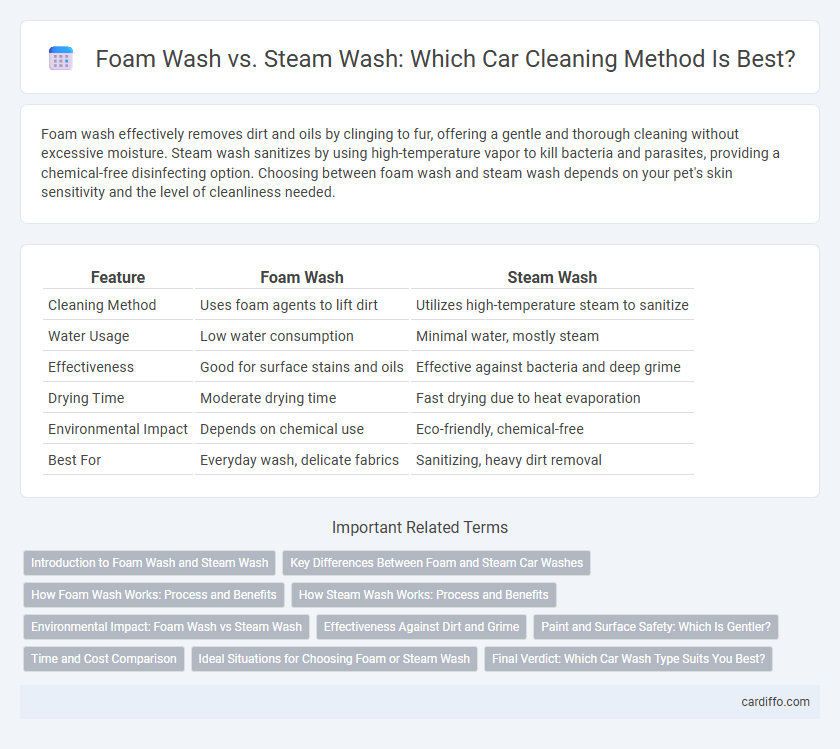Foam wash effectively removes dirt and oils by clinging to fur, offering a gentle and thorough cleaning without excessive moisture. Steam wash sanitizes by using high-temperature vapor to kill bacteria and parasites, providing a chemical-free disinfecting option. Choosing between foam wash and steam wash depends on your pet's skin sensitivity and the level of cleanliness needed.
Table of Comparison
| Feature | Foam Wash | Steam Wash |
|---|---|---|
| Cleaning Method | Uses foam agents to lift dirt | Utilizes high-temperature steam to sanitize |
| Water Usage | Low water consumption | Minimal water, mostly steam |
| Effectiveness | Good for surface stains and oils | Effective against bacteria and deep grime |
| Drying Time | Moderate drying time | Fast drying due to heat evaporation |
| Environmental Impact | Depends on chemical use | Eco-friendly, chemical-free |
| Best For | Everyday wash, delicate fabrics | Sanitizing, heavy dirt removal |
Introduction to Foam Wash and Steam Wash
Foam wash uses dense bubbles to lift dirt and grime gently from surfaces, providing an effective yet soft cleaning method suited for delicate fabrics and objects. Steam wash relies on high-temperature steam to sanitize and loosen stubborn contaminants without harsh chemicals, making it ideal for deep cleaning and disinfecting. Both techniques offer eco-friendly solutions by reducing water usage and minimizing chemical detergent requirements.
Key Differences Between Foam and Steam Car Washes
Foam wash uses thick, clinging foam detergents that break down dirt and grime on a vehicle's surface, allowing for a gentler, physically scrubbed clean. Steam wash utilizes high-temperature steam to sanitize and loosen contaminants without the need for harsh chemicals, offering an eco-friendly and water-efficient option. Key differences include foam wash's reliance on chemical agents and physical scrubbing, while steam wash emphasizes thermal cleaning with minimal water usage and chemical impact.
How Foam Wash Works: Process and Benefits
Foam wash operates by generating dense foam infused with specialized cleaning agents that penetrate fabric fibers to break down dirt and stains effectively while using less water. The foam's structure allows for efficient agitation and thorough coverage, enhancing stain removal without the abrasive effects of traditional washing methods. This process results in energy savings, reduced water consumption, and fabric care benefits, making foam wash an eco-friendly and fabric-safe alternative to conventional steam washing techniques.
How Steam Wash Works: Process and Benefits
Steam wash utilizes high-temperature steam to penetrate fabric fibers, loosening dirt and eliminating bacteria without harsh chemicals. The steam's moisture and heat effectively sanitize clothes while reducing wrinkles and allergens, making it ideal for sensitive skin. This process conserves water and energy compared to traditional foam wash methods, offering an eco-friendly and efficient cleaning alternative.
Environmental Impact: Foam Wash vs Steam Wash
Foam wash significantly reduces water consumption by using air-infused cleaning agents, leading to lower wastewater production compared to traditional methods. Steam wash employs high-temperature steam to sanitize surfaces without chemicals, minimizing chemical runoff and reducing the overall environmental footprint. Both methods offer eco-friendly alternatives, with foam wash optimizing water use and steam wash decreasing chemical pollution.
Effectiveness Against Dirt and Grime
Foam wash penetrates and lifts dirt particles effectively through dense bubbles that cling to surfaces, making it ideal for removing surface grime and oils. Steam wash uses high-temperature vapor to break down and dissolve stubborn dirt and grease deeply embedded in fabrics or surfaces, ensuring a thorough clean. Comparing both, steam wash typically offers superior effectiveness against tough grime, while foam wash excels in gentle and efficient removal of lighter dirt.
Paint and Surface Safety: Which Is Gentler?
Foam wash creates a thick layer of suds that cushions the paint, minimizing abrasion and protecting delicate surfaces from scratches. Steam wash uses high-temperature vapor to loosen dirt without harsh chemicals, reducing the risk of paint damage from friction or pressure. Both methods offer gentle cleaning, but foam wash is typically safer for older or more sensitive paint finishes due to its cushioning effect.
Time and Cost Comparison
Foam wash consumes significantly less water and detergent, reducing overall cleaning time and operational costs compared to steam wash, which requires longer heating periods and higher energy consumption. Industrial foam washing systems can complete cycles in under 15 minutes, whereas steam wash methods often exceed 30 minutes due to the need to reach and maintain high temperatures. Cost analysis shows foam wash reduces expenses by up to 40% in energy and water usage, making it a more efficient option for businesses prioritizing time and budget savings.
Ideal Situations for Choosing Foam or Steam Wash
Foam wash is ideal for delicate fabrics and garments with surface stains, providing gentle yet effective cleaning without excessive moisture. Steam wash is best suited for heavy soiling, deep wrinkles, and sanitizing purposes, as its high-temperature vapor penetrates fibers to remove dirt and kill bacteria. Choosing between foam and steam wash depends on fabric type, stain severity, and desired sanitation level for optimal garment care.
Final Verdict: Which Car Wash Type Suits You Best?
Foam wash uses detergent-rich suds to lift dirt without abrasive action, ideal for delicate paint finishes and areas requiring thorough surface cleaning. Steam wash utilizes high-temperature steam to sanitize and remove grime efficiently, offering eco-friendly benefits with minimal water usage and quick drying times. Choosing between foam and steam wash depends on your vehicle's paint sensitivity, environmental preferences, and the level of dirt removal needed for optimal care.
Foam Wash vs Steam Wash Infographic

 cardiffo.com
cardiffo.com